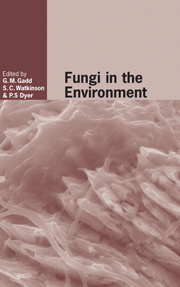Book contents
- Frontmatter
- Contents
- List of contributors
- Preface
- I Imaging and modelling of fungi in the environment
- II Functional ecology of saprotrophic fungi
- III Mutualistic interactions in the environment
- 8 Mycorrhizas and the terrestrial carbon cycle: roles in global carbon sequestration and plant community composition
- 9 Water relations in lichens
- 10 Development of the arbuscular mycorrhizal symbiosis: insights from genomics
- IV Pathogenic interactions in the environment
- V Environmental population genetics of fungi
- VI Molecular ecology of fungi in the environment
- Index
- References
10 - Development of the arbuscular mycorrhizal symbiosis: insights from genomics
from III - Mutualistic interactions in the environment
Published online by Cambridge University Press: 03 November 2009
- Frontmatter
- Contents
- List of contributors
- Preface
- I Imaging and modelling of fungi in the environment
- II Functional ecology of saprotrophic fungi
- III Mutualistic interactions in the environment
- 8 Mycorrhizas and the terrestrial carbon cycle: roles in global carbon sequestration and plant community composition
- 9 Water relations in lichens
- 10 Development of the arbuscular mycorrhizal symbiosis: insights from genomics
- IV Pathogenic interactions in the environment
- V Environmental population genetics of fungi
- VI Molecular ecology of fungi in the environment
- Index
- References
Summary
Introduction
The majority of the vascular flowering plants have the ability to enter into symbiotic associations with a unique group of soil fungi, the arbuscular mycorrhizal (AM) fungi. The symbiosis develops in the roots of the plant, where the plant provides the fungus with a source of carbon and the fungus delivers mineral nutrients to the roots. In particular, the transfer of phosphorus from the AM fungus to the plant is widely documented, but there is evidence for zinc and nitrogen transport also (Hodge et al., 2001). For both symbionts, significant quantities of nutrients may be exchanged. It is estimated that the plant allocates up to 20% of its photosynthate to the roots to support the fungal symbiont, and some studies suggest that in an AM symbiosis the plant receives all of its phosphorus via the fungus (Bago et al., 2000; Smith et al., 2003). Phosphorus is a relatively immobile nutrient and is often present at concentrations in the soil that are limiting for plant growth. Consequently, improvements in phosphorus supply resulting from the AM fungus can have a significant impact on plant health and subsequently on plant biodiversity and ecosystem productivity (van der Heijden et al., 1998).
The AM symbiosis is an ancient association. Both molecular data and fossil evidence suggest that the AM fungi originated 460 MYA (Redeker et al., 2000) at a time when bryophytes were the predominant plant form.
- Type
- Chapter
- Information
- Fungi in the Environment , pp. 201 - 224Publisher: Cambridge University PressPrint publication year: 2007



